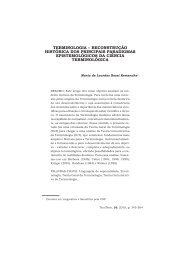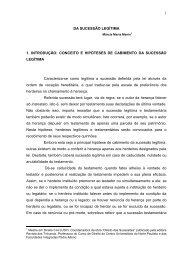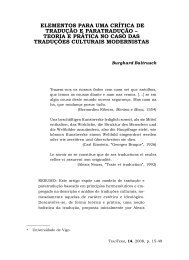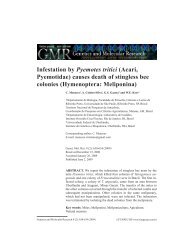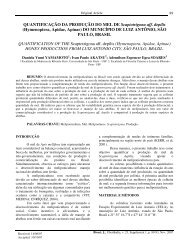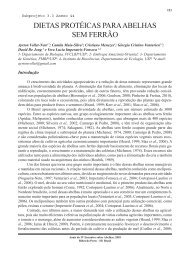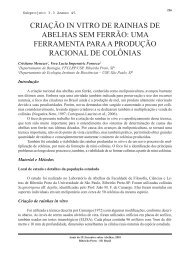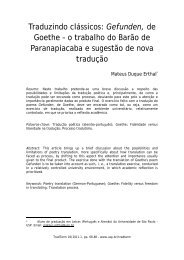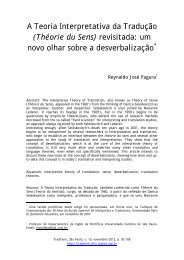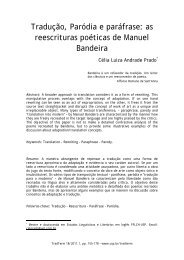Bees as pollinators in Brazil - USP
Bees as pollinators in Brazil - USP
Bees as pollinators in Brazil - USP
Create successful ePaper yourself
Turn your PDF publications into a flip-book with our unique Google optimized e-Paper software.
ed <strong>in</strong> strawberry greenhouse, and the results<br />
of its efficiency is <strong>in</strong> Bego, et al., The other<br />
colonies were used to study foragers’ behaviour<br />
under greenhouse condition (Bego, et al.,<br />
1989a). Later on, Trigona m<strong>in</strong>angkabau from<br />
Sumatra w<strong>as</strong> also tested <strong>in</strong> strawberry greenhouses,<br />
and the result compared with the efficiency<br />
of Apis <strong>in</strong> the same greenhouses<br />
(Katutani, et al., 1993).<br />
In <strong>Brazil</strong>, st<strong>in</strong>gless bees <strong>as</strong> <strong>poll<strong>in</strong>ators</strong> for<br />
strawberries <strong>in</strong> greenhouses were tested by<br />
Malagodi-Braga (1992); Malagodi-Braga and<br />
Kle<strong>in</strong>ert (2004). Protocols for greenhouse poll<strong>in</strong>ation<br />
are well established related to the use<br />
of Tetragonisca angustula and other small<br />
st<strong>in</strong>gless bees. Malagodi-Braga & Kle<strong>in</strong>ert<br />
(2004) showed the efficiency of Tetragonisca<br />
angustula <strong>as</strong> a poll<strong>in</strong>ator <strong>in</strong> “Oso Grande”<br />
cultivar: <strong>in</strong> a greenhouse with 1350 plants<br />
almost 100% of flowers developed <strong>in</strong>to wellshaped<br />
fruits compared to 88% with open<br />
poll<strong>in</strong>ation <strong>in</strong> the field.<br />
Sweet pepper (Capsicum annuum, Sola -<br />
na ceae) is another crop cultivated around the<br />
world, <strong>in</strong> open fields and <strong>in</strong> greenhouses<br />
(where its cycle is extended for production all<br />
year round). Although sweet pepper is a selfpoll<strong>in</strong>at<strong>in</strong>g<br />
plant, it benefits from bee poll<strong>in</strong>ation<br />
(R<strong>as</strong>mussen, 1985). In <strong>Brazil</strong>, Cruz, et al.,<br />
(2005) tested the efficiency of Melipona subnitida<br />
<strong>as</strong> a greenhouse poll<strong>in</strong>ator of sweet<br />
pepper, variety All Big. They used four treatments<br />
<strong>in</strong> their research: hand cross-poll<strong>in</strong>ation,<br />
hand self-poll<strong>in</strong>ation, poll<strong>in</strong>ation by bees<br />
and restrict poll<strong>in</strong>ation. The fruit set w<strong>as</strong> not<br />
improved by the use of M. subnitida <strong>as</strong> <strong>poll<strong>in</strong>ators</strong>,<br />
but the number of seeds per fruit, the<br />
average fruit diameter and fruit weight<br />
<strong>in</strong>cre<strong>as</strong>ed; a lower percentage of malformed<br />
fruits were also found, compar<strong>in</strong>g with selfpoll<strong>in</strong>ated<br />
sweet pepper.<br />
Another important crop also often kept <strong>in</strong><br />
greenhouses <strong>in</strong> <strong>Brazil</strong> and worldwide is the<br />
Workshop I 77<br />
tomato, Lycopersicum esculentum. Velthuis<br />
(2002) tells the successful story of the bumblebee<br />
Bombus terrestris used <strong>as</strong> tomatoes <strong>poll<strong>in</strong>ators</strong><br />
<strong>in</strong> greenhouses <strong>in</strong> the Netherlands and<br />
Belgium that resulted <strong>in</strong> a big <strong>in</strong>dustry of bumble<br />
bee rear<strong>in</strong>g <strong>in</strong> various pary of the world.<br />
Nowadays 1 million colonies of Bombus terrestris<br />
are yearly sold for us<strong>in</strong>g <strong>in</strong> agriculture<br />
(Velthuis & Van Doorn, 2004). However, exotic<br />
<strong>poll<strong>in</strong>ators</strong> are to be avoided <strong>in</strong> many countries<br />
<strong>in</strong>clud<strong>in</strong>g <strong>Brazil</strong>. In search of local solutions,<br />
<strong>Brazil</strong> found that the use of some species<br />
of Melipona could be good <strong>poll<strong>in</strong>ators</strong> of<br />
some Solanaceae crops that need “buzz poll<strong>in</strong>ation”,<br />
such <strong>as</strong> the relatively large Melipona<br />
quadrif<strong>as</strong>ciata for tomatoes (Lycopersicum<br />
esculentum) grow<strong>in</strong>g <strong>in</strong> greenhouse (Del Sarto,<br />
et al., 2005). Nevertheless, Maci<strong>as</strong> & Ma ci<strong>as</strong><br />
(2001) and Cauich, et al., (2004) verified that<br />
Nanno trigona pirilampoides is a very successful<br />
poll<strong>in</strong>ator for tomatoes <strong>in</strong> greenhouses,<br />
open<strong>in</strong>g new possibilities for small st<strong>in</strong>gless<br />
bees use <strong>in</strong> those.<br />
Open field poll<strong>in</strong>ation<br />
and st<strong>in</strong>gless bees<br />
Heard & Exley (1994) already considered the<br />
importance of agricultural landscape and natural<br />
vegetation for provid<strong>in</strong>g poll<strong>in</strong>ation services<br />
(the abundance of Trigona carbonaria <strong>in</strong><br />
orchards of macadamia w<strong>as</strong> correlated with<br />
the extent of natural surround<strong>in</strong>g Eucalyptus<br />
vegetation). Venturieri (1993) also remarked<br />
the importance of natural vegetation around<br />
the cupu<strong>as</strong>su crop <strong>in</strong> order to provide the<br />
needed <strong>poll<strong>in</strong>ators</strong>. Kremen (2004) considered<br />
the importance of bee community <strong>as</strong> crop <strong>poll<strong>in</strong>ators</strong>,<br />
po<strong>in</strong>t<strong>in</strong>g out that if we ma<strong>in</strong>ta<strong>in</strong> several<br />
bee species from natural environments visit<strong>in</strong>g<br />
flowers, the shortage of one species <strong>in</strong><br />
one year could be compensated by the other<br />
visitor’s species, dim<strong>in</strong>ish<strong>in</strong>g the impact of <strong>poll<strong>in</strong>ators</strong>’<br />
shortage on crops.



